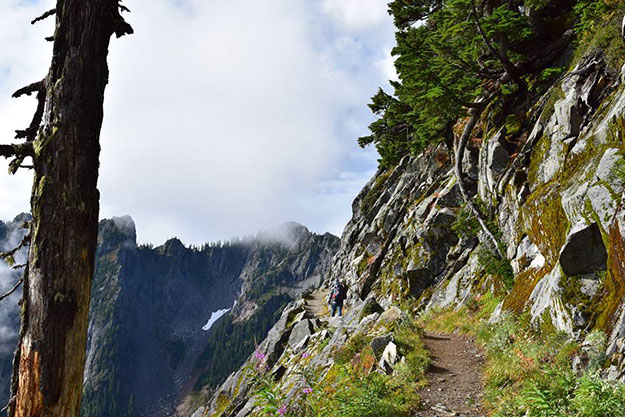If you're still sitting on the couch thinking about hiking as the rain patters outside your window this weekend, you're not taking advantage of living in the Pacific Northwest. Serious hikers across the region are already shaking the melancholy from their bones, readying themselves to hit the trails, and we think you should, too. For those who are determined to do some serious hiking this spring and summer, here's a short list of hikes that'll whip you into shape.
Lower Lena Lake Trail (7 miles, 1,200-foot elevation gain)
We know seven miles sounds like a long distance for your first hike of the season, but trust us, the gentle incline and lush overhang of pine trees on Lower Lena Lake Trail make for a relaxing, easy hike. Located on the Olympic Peninsula, this hike offers an out-and-back trail that takes you through old-growth forest, across dry creek beds and finally, to the stunning shores of Lena Lake. You'll only gain 1,200 feet of elevation on this hike, so expect to make it to Lena Lake within an hour or two. If you're daring, jump in the lake once you arrive to cool your body down ... way down.
 Mount Si Trail (7.6 miles, 3,277-foot elevation gain)
Mount Si Trail (7.6 miles, 3,277-foot elevation gain)
Once you've conquered Lower Lena Lake Trail, head to North Bend for something a bit more challenging: Mount Si Trail. Thanks to its steep incline -- 3,267 feet from the trailhead to the peak -- Mount Si Trail is nothing to scoff at. Most of your hike will take place on switchbacks, under the cover of trees, but the tail will eventually open to a rocky cliff covered in boulders. Here, you'll be rewarded with incredible views of the surrounding mountain range, and below, the charming city of North Bend. If you still have energy after your climb, you can attempt an ascent of "The Haystack," an exposed scramble (an outcrop of rock requiring your hands to climb up it) at the end of the trail. As many hikers ascend Mount Si in preparation for tackling Mount Rainier, you'll want to make sure to snap a selfie at the end of the trail, otherwise you'll miss out on some serious bragging rights.
Hikers Hut Loop Trail (10 miles, 3,067-foot elevation gain)
With distance and difficulty under your belt, you'll be ready to tackle Hikers Hut Loop Trail. This long -- but not terribly strenuous -- hike is in Tiger Mountain State Forest, near Issaquah. The first portion of the hike is typically a bit crowded, but once you pass Poo Poo Point (about three miles in) you'll find yourself delightfully alone with the trees, weeds and forest critters. Close to half-way through the hike, you'll find Hikers Hut, a teensy metal hut where many an outdoorsman has camped overnight. Partly because the hut is so small (most people would not be able to lay out head-to-toe), we recommend eating lunch on a rough-cut bench just outside the hut while enjoying the views, before jumping back on the trail to finish the loop in the same day.
Kendall Katwalk (14.5 miles, 3,858-foot elevation gain)
Do not let the distance or elevation of Kendall Katwalk Trail scare you. Yes, the trail is over 14 miles long, and yes, you'll need to climb almost 4,000 feet before it levels off, but the experience will be unforgettable. Kendall Katwalk Trail is an out-and-back trail on Snoqualmie Pass, and it's part of the Pacific Crest Trail. The hike takes you through pristine, forested area, then along loose and rocky mountainside until you reach the mountain ridge. Here, the trail becomes a path, one which was blasted from a steeply sloped cliff face. You'll need to hug the cliff wall for the last mile or so, as the drop-off on the other side is not only terrifying, but deadly. But, if you can overcome your fear, you'll arrive at a mountaintop meadow where campsites and a sparkling lake await you. Allow yourself a day to ascend to the katwalk and lake, and a second day to return to the trailhead. If and when you complete this trail, you'll be ready for anything.
Pro tips for hiking season
- Increase your endurance: start by taking a walk for 20-30 minutes, two or three days a week. Then, slowly increase your walking time until you’re able to walk for two to three hours comfortably. Your body will thank you later on the trail, for easing into longer time/distances.
- Get reacquainted with your pack: dust off your favorite hiking backpack and take it with you on your walks. For now, keep the weight low, then slowly add weight over time. This will let your body get re-accustomed to carrying the weight of your pack without physical discomfort.
- This is also a great opportunity to organize and restock your hiking supplies. We suggest you:
*Clean your camelback reservoir and hose
*Restock your first aid kit
*Throw your favorite pair of hiking gloves, an extra pair of socks, and a
bandana or beanie into your pack
*Tuck a small multi-tool or knife and a thin rope into a side pocket on
your pack
*Restock water purification tablets and/or check your water purification pump
*Grab a few snacks -- dry goods like granola or energy bars -- and tuck them
into your pack for unexpected cravings on the trail
- Clean your hiking boots: raise your hand if you left your hiking boots covered in mud last season and they’ve been marinating in the corner of the garage all winter. Yeah, so did we. So, brush off that layer of dried mud, slip your boots on, and go for your weekly walk. If your feet don’t protest after a few treks, chances are your boots have another season of trails left in them.





Read Comments